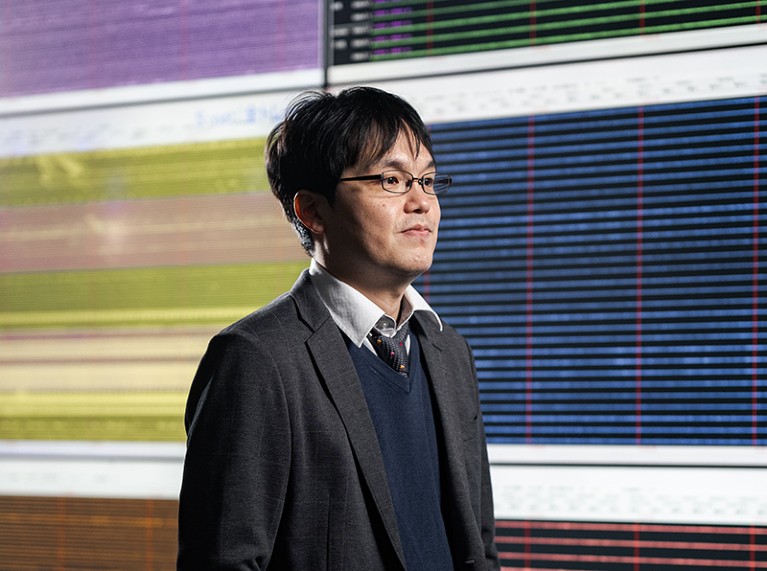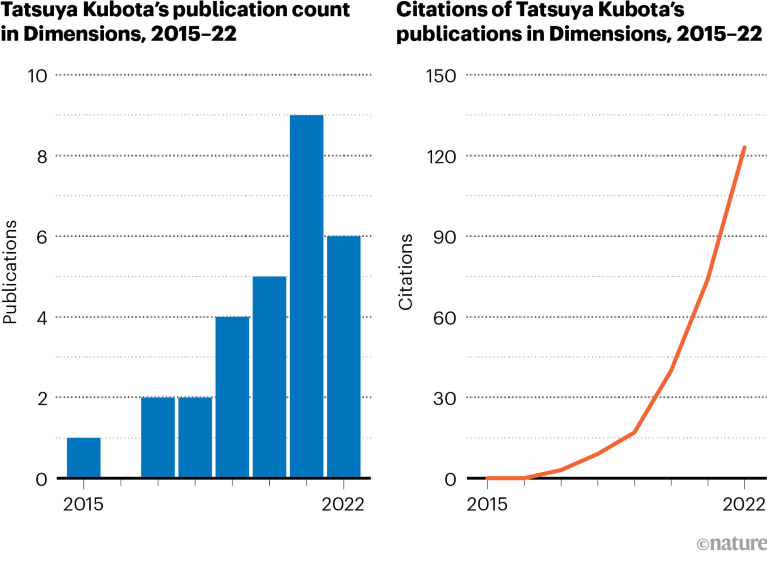
Tatsuya Kubota resolved to be a seismologist in 2011 when an earthquake struck Tohoku, where he was a geology undergraduate.Credit: Irwin Wong for Nature
This is the third in a Nature Index series of profiles about emerging early-careers researchers in Japan.
It was the Tohoku earthquake and tsunami in March 2011 that cemented Tatsuya Kubota’s resolve to become a seismologist. Then a final-year geology undergraduate at Tohoku University in Sendai, Japan, Kubota was doing benchwork when the ground started to shake violently, and books began to crash from their shelves.
He fled the building and spent the next few weeks sheltering at home. Sendai, located some 130 kilometres from the epicentre, was mostly spared the large-scale physical damage of Ishinomaki and other coastal cities in the region. But its residents had to endure weeks without water and electricity in unforgiving temperatures.
The 9.0-magnitude earthquake and ensuing tsunami, which also caused the nuclear disaster at Fukushima, claimed nearly 20,000 lives. Scientists have yet to “reach a decisive conclusion” as to why the earthquake — one of the most powerful ever recorded — happened, says Kubota, now a research fellow at Japan’s National Research Institute for Earth Science and Disaster Resilience in Tsukuba.
When tectonic plates slide under each other, they sometimes become stuck, causing an immense build-up of energy, which when released results in an earthquake. Such ‘stick-slips’, as they’re called, usually occur deep underground where the pressure is higher and plates tend to lock most strongly together, says Kubota. But in the case of the Tohoku earthquake, the Pacific plate and North American plate became stuck at both deep and shallow portions (less than 10 kilometres from the sea floor). “As far as I know, no other earthquake has had such an extremely large slip in the shallow portion like this,” he says.
For years, scientists have deliberated over this anomaly. Underwater sensors near the epicentre only went as deep as 3 kilometres, and the closest onshore data were recorded more than 200 kilometres away from the rupture, so data were hard to come by. But Kubota knew solving the mystery was crucial: shallow ruptures, unlike earthquakes that originate deep underground, result in larger vertical movements of the sea floor and thus bigger tsunamis. “Understanding the mechanism of shallow earthquake slips is important for better predicting possible tsunami risks,” he explains.
Kubota and his collaborators first combined existing data (which measure sea-floor location before and after an earthquake) with tsunami data recorded by pressure gauges on the ocean floor directly above the fault zone (that offer information about changes to the sea surface). They invented a modelling method to analyse the data.

Source: Dimensions
In 2022, the researchers reported their findings1: in the case of the Tohoku earthquake, the Pacific plate was pinned beneath the Okhotsk tectonic plate so strongly that the two moved together as one, until the stress simply grew too great. “This deep mechanical locking was then released, which caused the earthquake and provoked slips in both the deep and shallow parts of the plate boundary,” explains Kubota. “Our analyses provided us with a new mechanical perspective in which shallow slips can occur without the energy accumulation in the shallow portion.”
Kubota — among the top five most prolific early-career researchers in Japan for Nature Index publications in the Earth and environmental sciences since 2015 — was also was the lead author of a Science paper2 published last year that examined how the powerful Hunga Tonga–Hunga Ha‘apai volcanic eruption in January 2022 triggered damaging tsunamis hundreds of kilometres away in Australia, New Zealand and Japan,
“The surprising feature was that the first waves arrived two hours earlier than what is expected for conventional tsunamis,” says Kubota. The waves also lasted for much longer than would usually be the case. Using computer simulations, he and his co-authors revealed that the Tonga tsunamis were formed because the eruption was so strong — up to 500 times more powerful than the atomic bomb dropped on Hiroshima in the Second World War — that it caused the whole atmosphere to vibrate. These vibrations, in the form of something known as Lamb waves, raced across the globe at the speed of sound and drove the initial tsunamis. The researchers are now studying the later Tonga tsunamis. As Kubota explains: “The mechanism of the secondary waves isn’t well-clarified, but the waves [generated] are larger.”
He says that a greater understanding of such natural phenomena is crucial to mitigating future disasters. “I hope my studies will be useful to risk evaluation of future tsunamis and earthquakes.”


 Is Japan’s research decline turning a corner?
Is Japan’s research decline turning a corner?
 How Japanese science is trying to reassert its research strength
How Japanese science is trying to reassert its research strength
 Japan’s leading international partnerships
Japan’s leading international partnerships
 Freeing up Japan’s PhD potential
Freeing up Japan’s PhD potential
 Japan’s rising research stars: Mariko Kimura
Japan’s rising research stars: Mariko Kimura
 Japan’s rising research stars: Yuuki Wada
Japan’s rising research stars: Yuuki Wada
 Japan’s rising research stars: Yasuka Toda
Japan’s rising research stars: Yasuka Toda
 Japan’s rising research stars: Ken-ichi Otake
Japan’s rising research stars: Ken-ichi Otake
 Will Japan’s new ¥10-trillion university fund lift research performance?
Will Japan’s new ¥10-trillion university fund lift research performance?
 Shoring up Japan’s research performance
Shoring up Japan’s research performance
 How Japan’s disciplinary strengths are shifting focus
How Japan’s disciplinary strengths are shifting focus
 Japanese robotics lags as AI captures global attention
Japanese robotics lags as AI captures global attention





